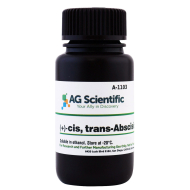Abscisic acid (ABA), also known as abscicin II and dormin, is a plant hormone. ABA functions in many plant developmental processes, including bud dormancy and resistance to abiotic stresses. During drought, the plant hormone Abscisic acid (ABA) inhibits stomatal opening and promotes stomatal closure, thereby promoting water conservation.
Abscisic acid (ABA) (also known as abscicin II or dormin) is a plant hormone. ABA functions in many plant developmental processes, ranging from seed and bud dormancy to resistance to abiotic stresses such as drought, salinity, and extreme temperatures. Abscisic acid (ABA) inhibits stomatal opening and promotes stomatal closure, thereby increasing water conservation.
What does abscisic acid (ABA) look like?
Abscisic acid is a white powder.What enzyme degrades abscisic acid (ABA)?
ABA degradation is catalyzed by enzymes belonging to the ancient cytochrome P450 superfamily. These enzymes play an important role in degrading hormones such as abscisic acid.What is the difference between (S)-ABA and (R)-ABA?

The structures of these two compounds, both of which exhibit a cis configuration between the methyl at C-2 and the carbon side chain, are shown in the above picture. The stereochemistry at C-1 of PBI-63 is the same as natural (S)-ABA. PBI-51 is similarly related to (R)-ABA. (S)-ABA is clearly more active at lower concentrations (1-10µM) than (R)-ABA.
Can abscisic acid be used for medical purposes?
Abscisic acid is a potential candidate for medicine. ABA has recently been shown to elicit potent anti-inflammatory and anti-diabetic effects in mouse models of diabetes and obesity, inflammatory bowel disease (IBD), atherosclerosis and influenza infection.Are AtPYR/RCAR-related proteins found only in land plants?
Yes. Based on current genomic and functional data, AtPYR/RCAR-related proteins are found only in land plants. The earliest emergence of potential PYR/RCAR homologs can be observed at the evolutionary stage of Marchantia polymorpha (liverwort; MpPYRL1), a species assumed to represent the basal lineage of the land plant phylum.What factors are important for ABA synthesis?
The main environmental factor leading to the formation of abscisic acid (ABA) in Arabidopsis is any form of limitations in cellular water availability. In some lower photosynthetic organisms, drought and salinity can also trigger ABA synthesis, as seen in lichens, cyanobacteria and algae (although less is known about these pathways). In non-photosynthetic organisms, heat and nutrient limitation can affect ABA concentrations.What is the core ABA signaling pathway?
Recent progress in understanding early ABA signal transduction has led to the construction of a PYR/RCAR “PP2C” SnRK2 signal transduction model. In the absence of ABA, PP2Cs inhibit protein kinase (SnRK2) activity through removal of activating phosphates. ABA is bound by intracellular PYR/PYL dimers, which dissociate to form ABA receptor “PP2C” complexes. Complex formation therefore inhibits the activity of the PP2C in an ABA-dependent manner, allowing activation of SnRK2s. Several SnRK2 targets have been identified both at the plasma membrane and in the nucleus, resulting in control of ion channels, secondary messenger production, and gene expression. Red connections on left indicate an inhibitory interaction.
Biochemical evidence providing information on enzymatic explains about the involvement of a specific component in ABA-induced stomatal closure. For example, the putative G protein-coupled receptor 1(GCR1) can physically interact with the heterotrimeric G protein a component 1(GPA1) as supported by split-ubiquitin and coimmunoprecipitation experiments.
What experimental evidence is there supporting the mechanism of stomatal closure?
There are two pieces of evidence in different categories. First, genetic evidence of differential responses to a stimulus in wild-type plants versus mutant plants implicates the product of the mutated gene in the signal transduction process. For example, the ethyl methanesulfonate generated ost1 mutant is less sensitive to abscisic acid; thus, one can infer that the OST1 protein is a part of the ABA signaling cascade. Second, pharmacological experiments, in which a chemical is used either to mimic the elimination of a particular component, or to exogenously provide a certain component, can lead to similar inferences. For example, a nitric oxide (NO) scavenger inhibits ABA-induced closure, while a NO donor promotes stomatal closure; thus, NO is a part of the ABA network. The two types of inference do not give direct interactions but correspond to pathways and pathway regulation. The existing theoretical literature on signaling is focused on networks where the biochemical information is known, along with the kinetics of each interaction. However, the availability of such detailed knowledge is very much the exception rather than the norm in the experimental literature.Sources:
- Katharine E. Hubbard, Noriyuki Nishimura, et al. Early abscisic acid signal transduction mechanisms: newly discovered components and newly emerging questions. 2010;24:1695-1708.
- Bob Asselbergh, David De Vleesschauwer, and Monica Höfte. Global Switches and Fine-Tuning ABA Modulates Plant Pathogen Defense. 2008;21:709-719.
- Felix Hauser, Rainer Waadt, et al. Evolution of Abscisic Acid Synthesis and Signaling Mechanisms. 2011;21:346-355.
- Song Li, Sarah M. Assmann, et al. Predicting Essential Components of Signal Transduction Networks: A Dynamic Model of Guard Cell Abscisic Acid Signaling. 2006;4:e312.
- Josep Bassaganya-Riera et al. Method of using abscisic acid to treat diseases and disorders. 2010.
- Ronald W. Wilen, Dirk B. Hays, et al. Competitive inhibition of Abscisic Acid-Regulated Gene Expression by Stereoisomeric Acetylenic Analogs of Abscisic Acid. 1993;101:469-476.
